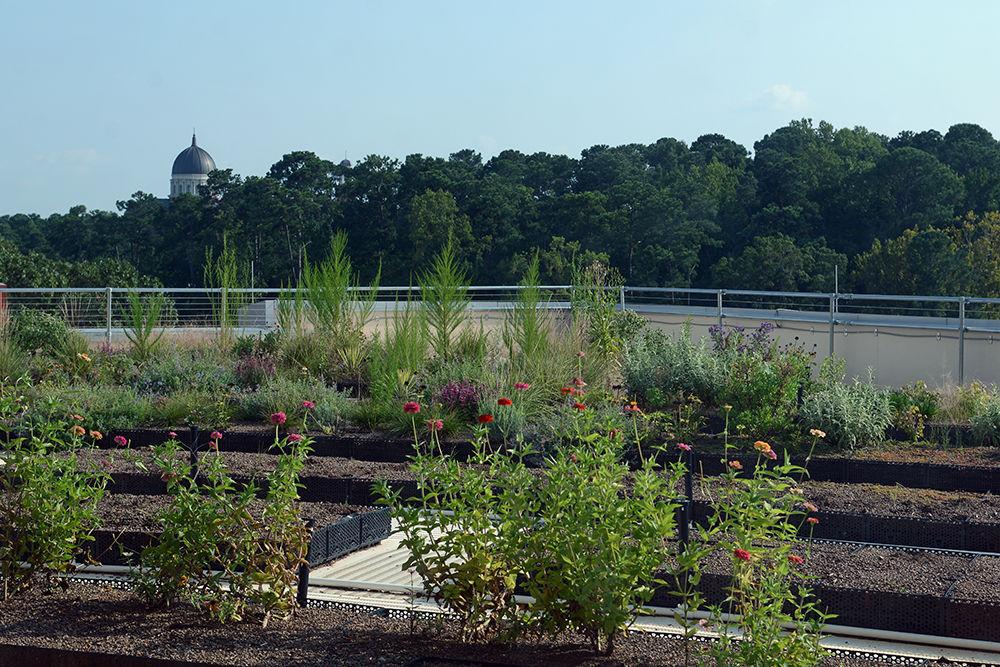
Brady Dillingham
The new rooftop garden on the fifth floor of Talley Student Union overlooks Carmichael Gymnasium. It was created by the University Sustainability Office, and grows both edible and inedible plants.
Talley Student Union’s recently completed rooftop garden is a student-driven space that houses edible plants, flowers and pollinators.
Creation and maintenance of the garden has been led by Anne Spafford and Danesha Seth Carley, both associate professors of horticulture science. Planning began back in fall 2016, and construction began in 2017, according to Spafford.
“We started building summer of 2017, so they craned up trays and bags of soil, and we had volunteers spread the soil,” Spafford said. “We planted that fall, but before then my students researched what plants would be both good for green roofs and pollinators. This is why it’s cool; it’s a student-driven project.”
This student focus is key, according to Seth Carley. The hope is that students working on the garden can really see the impacts of the space firsthand.
“They can actually see the plants that we’re planting really are drawing in very important animals, in this case bees, and they can see it happening,” Seth Carley said. “It sparks conversation and hopefully an interest maybe they didn’t even know they had.”
TJ Willis, associate director of University Student Centers, has been involved with the project alongside Spafford and Seth Carley, serving as a liaison between Talley and the two professors. He said that there was a lot of interest in the garden from students.
“We’ve had a couple of groups reach out to us, wanting to volunteer or get out there, so we have given them tour dates,” Willis said. “I think people are excited. It’s something you get to do that’s different on campus, and something you don’t have access to every day.”
Seth Carley explained that the space was designed to be shared with University Dining, so one section would be used for growing edible plants, and the other for creating a pollinator habitat.
“My research is pollinator habitats,” Seth Carley said. “So, the plants that we installed were primarily pollinator-friendly plants, but in addition it needed to be a space where the dining here could also harvest vegetables or herbs for [the 1887 Bistro].”
Spafford said that proper pollination is imperative to food production, which makes this a subject of great importance to students.
“If you’re interested at all in eating food, you should be concerned with pollinators,” Spafford said. “Even if you hate fruits and vegetables, and you eat only meat, a lot of animals eat plants that need to be pollinated by insects.”
Natural habitats have been dwindling with increased urban development, so creating habitats for pollinators is crucial, according to Seth Carley.
“Think about it as, this is their supermarket,” Seth Carley said. “This is where they can go to find both protein and sugar; that’s what they get from pollen and nectar to feed themselves and feed their young. Native bees, not honey bees, will burrow into hollow grass stems and lay their eggs. It’s also a home.”
Green roofs have many other benefits, according to Spafford, including reducing stormwater runoff and heating/cooling loads on buildings. On top of this, she is especially excited about de-stressing possibilities.
“Research has also shown that looking out onto a garden setting can reduce blood pressure and can help to de-stress you,” Spafford said. “Even looking out at a garden space or a green space can be hugely restorative.”
Willis hopes to see more projects like this in the future, but said that they will require both money and engagement from passionate students, faculty and staff.
NC State Sustainability released a video outlining the garden and some of the planting process. Anyone interested in getting involved with the garden or taking a tour should contact Spafford at amspaffo@ncsu.edu.